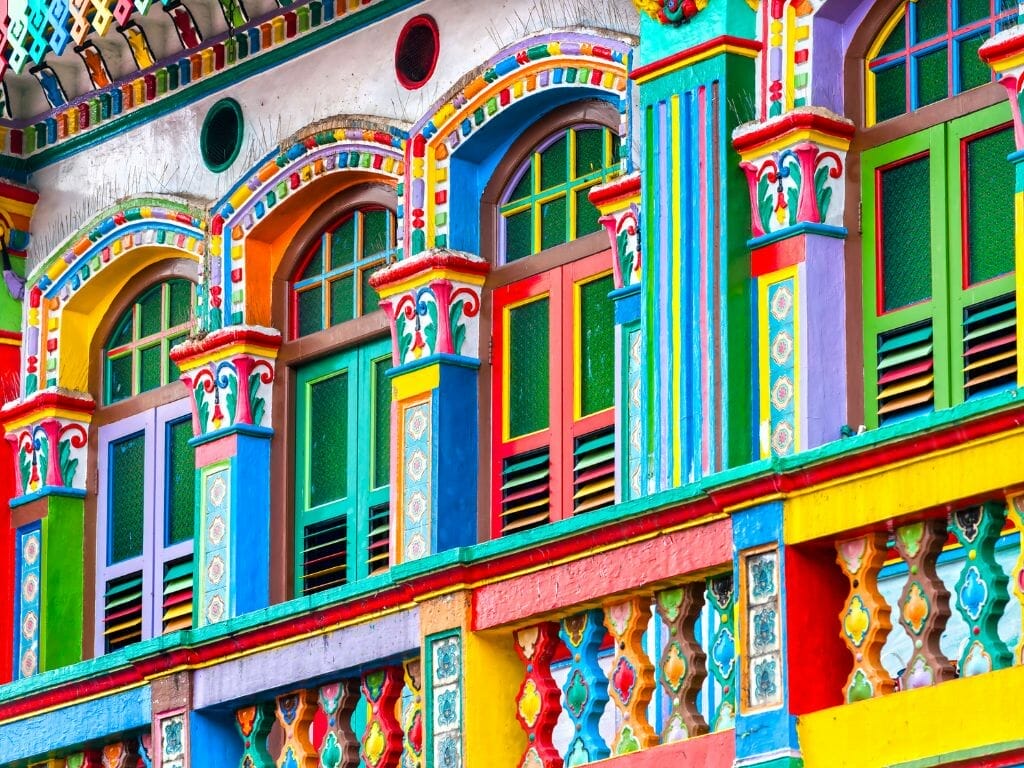Top 10 Things to See and Do at Little India, Singapore
Little India, Singapore is a small enclave of Indian immigrants and their descendants who have made the city their home. The district is densely packed with spice shops and restaurants, many of which cater to the Indian community, as well as Buddhist temples and Hindu temples. The district has a rich cultural heritage that continues to be passed down through the generations. If you are at Little India, these are our recommended top 10 things to visit.
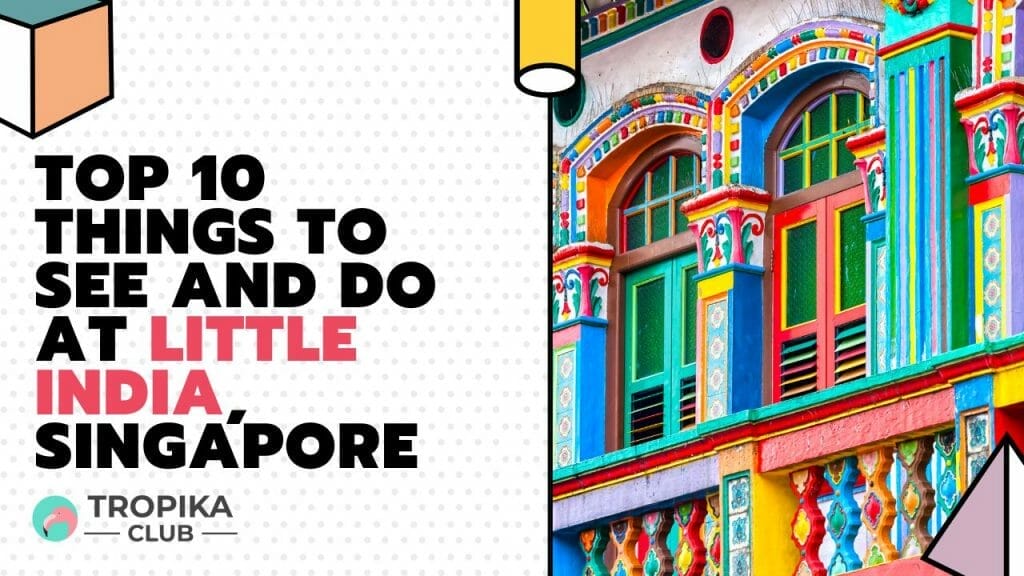
Table of Contents
- #1 – Sri Veeramakaliamman Temple
- #2 – Serangoon Road, The Main Street Of Little India
- #3 – Indian Heritage Centre
- #4 – Sri Srinivasa Perumal Temple
- #5 – Tan Teng Niah House
- #6 – The Temple Of 1,000 Lights – Sakya Muni Buddha Gaya Temple
- #7 – Tekka Centre
- #8 – Abdul Gaffoor Mosque
- #9 – Mahatma Gandhi Memorial Hall
- #10 – Little India Arcade
#1 – Sri Veeramakaliamman Temple
Introduction:
From its earliest days, it was linked with early migrant workers from India, who would have worshipped the goddess to feel safe in a new foreign land. One of its first names was Soonambu Kambam Kovil, or the “temple at the lime village” in Tamil. Many Indians who prayed at the temple worked in lime kilns in the area.
During the Japanese air raids in World War II, many people sought physical refuge at the temple as well as prayed for Kali’s protection. As luck—or fate—would have it, the temple and all its statues escaped the bombings unscathed. In the 1980s, major reconstruction work took place, with a gopuram (front tower) added as well as eight main domes and several minor ones. The annexe building was also built at the back of the temple.
It was again renovated in 1999, with the temple’s consecration ceremony taking place in 2000. In June 2014, the temple had another consecration ceremony which marked the culmination of the major restoration works, as well as the construction of a new six-storey building with various new facilities including a wedding hall, multipurpose hall and staff quarters. With its colourful and intricate statues and detailing, the temple remains one of the most spectacular places of worship in Singapore.
About
- Kali Story
- To the Devi who abides in all beings in the form of intelligence Salutations to Her, Salutations to Her,Salutations again and again
- The Divine Mother’s magic is as ancient as life itself. She existed before gods and mortals, and she will still exist even after the great dissolution. Mother is pure energy in subtle form, but in times of need or just out of a desire to play, she manifests.
- Many people fear the mysterious black goddess Kali. Her symbolism startles them because they try to understand with their brain. One needs to understand with one’s heart. Kali is an experience, a very personal one. If one gets a taste of the ecstasy of Her Divine Love even only once, one’s life is transformed and becomes holy.
- MOTHER GODDESS
- The worship of a mother goddess as the source of life and fertility has prehistoric roots, but the transformation of that deity into a Great goddess of cosmic powers was achieved with the composition of the Devi Mahatmya (Glory of the goddess), a text of the fifth to sixth century, when worship of the female principle took on dramatic new dimensions. The goddess is not only the mysterious source of life,she is the very soil, all-creating and all consuming.
- SRI PERIACHI
- Truly a mother to all living beings. She grants the boon of child to childless.Furthur she protects the woman from endless labour pain and gives fortunes and good health. She appears in a standing position and blesses those who worship her, with childrens.
Location: 141 Serangoon Rd, Singapore 218042
Opening Hours:
Tuesday : 5:30am–12pm, 5–9pm
Wednesday : 5:30am–12pm, 5–9pm
Thursday : 5:30am–12pm, 5–9pm
Friday : 5:30am–12pm, 5–9pm
Saturday : 5:30am–12pm, 5–9pm
Sunday : 5:30am–12pm, 5–9pm
Monday : 5:30am–12pm, 5–9pm
Price of Admission: $ Free
Contact: +65 6293 4634
Website: Website Link Here
#2 – Serangoon Road, The Main Street Of Little India
Introduction:
Little India | Streets off Serangoon Road
The area known as Little India of Singapore is where the main shopping commercial thoroughfare called Serangoon Road, that branches off into small lanes and streets that are lined with shops, small stores or even stalls that sells a wide range of authentic Indian cuisines and merchandise and Hindoo goods.
This vicinity is very accessible by Little India MRT station (subway); going out through one of the station exits will land you across Tekka Centre, from which you walk past it along Buffalo Road to reach the main Serangoon Road that meets it.
As you walk along Serangoon main Road from this point, you can see restaurants row selling Indian snacks & suppers, the signatures here being none other than the naans, pratas, and the mutton soup (kambing soup). Naans are usually rare if you ever see them, as the vicinity sells mainly South Indian foods, and naans are specialty breads that originated from North India. Down this main road, you will come to streets such as Campbell Lane, Upper Dickson Road, Veerasamy Road, Hindoo Road, Baboo Lane, and so on, 2 more streets down you will come to Syed Alwi Road where the main 24 hour shopping centre, Mustafa Centre, stands. If you feel that it is time to give your pair of sore feet some rest from the walking, you may want to consider popping by these two very popular Indian fastfood chain restaurants, Komala’s (9 Upper Dickson Road) and Ananda Bhavan Indian Vegetarian Restaurant (95 Syed Alwi Road) (highly recommended).
There is no specific trade or any particular merchandise or food that each lane sells as the streets in Little India operate in a similar way as how flea markets or night bazaars would have operated – although shops are located on the first floor of shophouses, they have small shop fronts and most of them push out mobile carts and set up tiny stalls in front, all fighting for patron’s attention. Indian spices, herbs and dried goods and daily groceries are interesting sights, a stall selling fruits and and vegetables can also be selling fresh jasmine flowers. Occasionally you will see them hand-making jasmine flower garlands and hanging them for sale. The traditional women wear jasmine flower garlands on their hair as fashion accessories. Indians probably have more spices & herbs to their name than any other ethnicities. The more commonly seen ones and those that tourists are happy to take home include red curry powder, curry leaves (karivepaku), turmeric powder (pasupu) & tamarind (chinthapandu). Some spices are sold fresh from their raw forms, upon selection, the shop owners have grinding machinery that helps to grind these spices into powder for easy packaging to take home.
In Singapore, it is no surprise that the good tailors around happen to be Indians. If you are adventurous enough, jolly well pop by a textile store, choose a silk fabric that you like, and get the in-house tailor to custom make a saree (or Sari), a traditional indian costume worn by women, with beautiful motif silk cloth wrapped around the waist at one end and the other draped over the shoulder, with the upper abdomen exposed (at midriff), to some, this costume can be incredibly sexy. This is to be worn with either a long skirt or long pants gathered & secured at the ankles, to make the whole look complete.
If you are into Bollywood movies, there are also plenty of Bollywood movie dvds & video cds spoilt for choice, and these are usually sold cheaper if you buy them in packs or bulk.
Old books, old art such as posters, photos, & other memorabilia and souveniers are also available for your pick.
About
Little India today is one of Singapore’s most vibrant districts. As you walk down Serangoon Road and neighbouring streets, explore their mix of Hindu and Chinese temples, mosques and churches. Fill your tummy with South Indian vegetarian food, North Indian tandoori dishes and local fare like roti prata (round pancakes) and teh tarik (pulled tea in Malay). Try to spot the brewers ‘pull’ the hot milk tea—it’s amazing showmanship. Don’t forget to shop. The 24-hour shopping mall Mustafa Centre offers everything from electronics to groceries, or take your pick from open-air Tekka Centre, goldsmith shops and sari stores. With its close proximity to the city and a bohemian vibe, many artists also call Little India home.
- A colourful past
- In the 1840s, Europeans lived here mainly for the racecourse, where they met and mingled.When cattle trading took root, it became a mostly Indian trade as traders hired Indian migrant workers. Certain goods and services took off, and mosques and Hindu temples were built.
Location: Serangoon Road, The Main Street Of Little India
Opening Hours:
- Daily
Price of Admission: $ Free
Website: Website Link Here

#3 – Indian Heritage Centre
Introduction:
The Indian Heritage Centre, under the management of the National Heritage Board and with support from the Indian community, traces the history of the Indian and South Asian communities in the Southeast Asian region.
The four-storey building is an iconic, unique and sustainable building that blends both traditional Indian as well as modern architectural elements. The architectural design for the facade is inspired by the baoli (or Indian stepwell), and seeks to create an urban forum for the celebration and appreciation of Indian culture. It houses five permanent galleries, a museum shop as well as programming and activity spaces.
The diversity and multi-faceted nature of Indian culture is also captured in the use of a translucent shimmering façade to create an impression of the Centre as a “shining jewel” in the day, and the transformation into a “glowing lantern” of the Indian community with the lighting of the colourful façade mural at night.
Situated at 5 Campbell Lane, the Centre also serves as a springboard for visitors to explore Little India and enjoy the sights, sounds and scents of the historical precinct. Indian Heritage Centre was opened by Prime Minister Lee Hsien Loong on 7 May 2015 and offers year-round exhibitions, programmes and activities to promote greater public awareness and appreciation of Indian heritage, arts and culture.
About
- INDIANS IN SINGAPORE: PAST & PRESENT
- Indian Heritage Centre’s permanent galleries (located at levels 4 and 3) feature five themes which are arranged chronologically to span 1st century CE to the 21st century. The galleries present, through artefact and interactive displays, the history of interactions between South and Southeast Asia, depict the experiences of the Indian community in both Singapore and Malaya during the colonial period, and highlight the contributions of the Indian and South Asian communities to Singapore’s nation-building efforts.
- 1st century CE to 19th century
- The first gallery explores the early contact between South and Southeast Asia and showcases the evidence of such interactions through the tangible and intangible heritage of the two regions. More specifically, it examines the religious connections (Hindu-Buddhist, Islamic and Christian) and the trade interactions between South and Southeast Asia vis-à-vis Singapore as a bustling hub of 19th century maritime trade.
- 19th to 21st centuries
- Indians in Singapore and Southeast Asia trace their origins to numerous waves of migration – pre-colonial, colonial and post-colonial. A complex history of migration from the South Asian subcontinent has produced a vibrant and dynamic community, made distinct by their ability to adapt and to integrate with local cultures. The “Roots” section of this gallery highlights their rites of passage, attire, language, religious affiliations and festivals while the “Routes” section revisits the gruelling journeys undertaken by migrants from their villages, cities and port towns, by ship to Singapore.
- 19th to mid-20th century
- The third gallery introduces the early Indian pioneers who arrived in Singapore and Malaya as well as their trades and businesses. It highlights the role of Indians such as prisoners and builders, moneylenders and private financiers, police and civil servants, traders and professionals etc. In addition, the gallery showcases the history and contributions of pioneering institutions including early Tamil schools, media establishments, religious monuments and social organisations.
- Mid-20th century
- The fourth gallery examines the impact of anti-colonial and nationalist movements in India on the Indian community in Singapore and Malaya. It also explores the impact of World War II on the local Indian community as well as the growth of social reform movements in both Singapore and Malaya.
- Late 1950s – Present
- The final gallery showcases the contributions of the Indian community in Singapore to the country’s nation-building efforts across diverse fields and occupations. It situates the Indian community within multi-cultural Singapore and highlights how the community continues to play an important role in shaping Singapore’s future.
Location: 5 Campbell Ln, Singapore 209924
Opening Hours:
Tuesday : 10am–7pm
Wednesday : 10am–7pm
Thursday : 10am–7pm
Friday : 10am–8pm
Saturday : 10am–8pm
Sunday : 10am–4pm
Monday : Closed
Price of Admission: Free admission to Singaporeans and Permanent Residents
Contact: +65 6291 1601
Website: Website Link Here
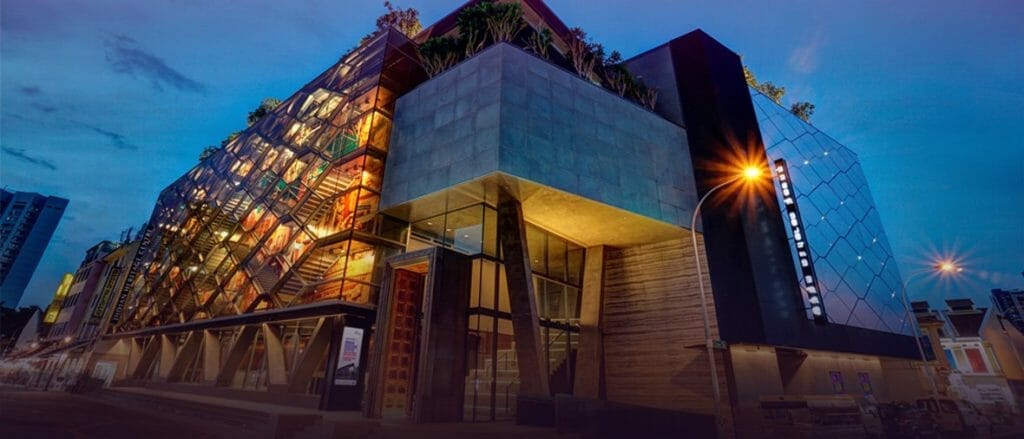
#4 – Sri Srinivasa Perumal Temple
Introduction:
Sri Srinivasa Perumal Temple or Sri Perumal Temple is one of the oldest temples in Singapore. It is located in Little India within the planning area of Kallang along Serangoon Road, where its tall Gopuram shows the different incarnations of Lord Vishnu.
About
The history of Sri Srinivasa Perumal temple dates back to the late 1800s when influential community leaders like Mr Arunachala Pillay, Mr Cootaperumal Pillay, Mr Ramasamy Pillay, Mr Appasamy Pillay, Mr Chockalingam Pillay and Mr Ramasamy Jamidar, all of whom had close working links with the East India Company, wanted to build a Hindu temple for Vaishnavite worship.
These men got together and purchased a piece of land measuring 2 acres 2 woods and 24 poles from the East India Company in 1851 for 26 rupees and 8 annas (at that period of time Indian currency was still used in the Settlement of Singapore). The temple they built in 1885 was referred to as the Narasinga Perumal Kovil.
Location: 397 Serangoon Rd, Singapore 218123
Opening Hours:
Tuesday : 8:30am–12pm, 6–9pm
Wednesday : 8:30am–12pm, 6–9pm
Thursday : 8:30am–12pm, 6–9pm
Friday : 8:30am–12pm, 6–9pm
Saturday : 8:30am–12pm, 6–9pm
Sunday : 8:30am–12pm, 6–9pm
Monday : 8:30am–12pm, 6–9pm
Price of Admission: $ 351
Contact: +65 6298 5771
Website: Website Link Here
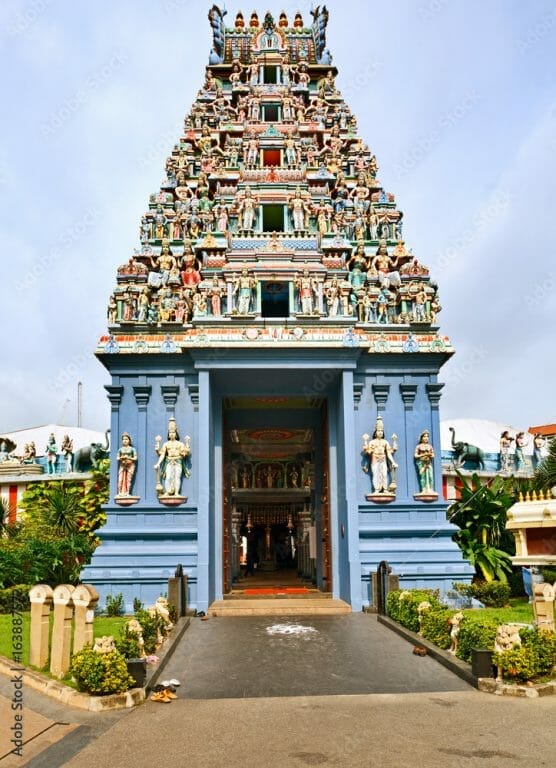
#5 – Tan Teng Niah House
Introduction:
Singapore’s heritage is rich, diverse, and—most importantly—ongoing. The National Heritage Board strives to preserve and catalogue the elements of that unique inheritance, and to present them to the public in an engaging and accessible format. As the custodians of culture, our goal is to capture the essence of what it means to be Singaporean.
Roots.gov.sg is a major milestone in that effort. Introduced in 2016, it houses our national collection, heritage trails, national monuments, historic sites, Intangible Cultural Heritage, and other multimedia assets under one roof, allowing us to transcend the limits of geography and create a space where Singaporeans can easily sample and share the fruits of our history.
With Roots.gov.sg, we’ve built a bigger doorway to our most cherished stories. We invite you to come inside, discover them, and contribute your own. Help us nurture a heritage for all to own.
About
Built in 1900, the former house of Tan Teng Niah is the last surviving Chinese villa in Little India. It embodies an often overlooked story of the days when small Chinese industries operated alongside the cattle and rattan businesses at Little India. Tan Teng Niah was a towkay(Chinese businessman of good standing) who owned several sweet-making factories along Serangoon Road that used sugarcane to produce sweets. Behind the house, Tan had a rubber smoke-house for drying rubber which used the by-products of sugarcane as fuel for its furnace.
The former house of Tan Teng Niah has eight rooms. The second storey overhangs the first to create a five-foot way (five feet wide covered pedestrian walkway) where there was once an entrance portico. On both sides of the house, there used to be carriage gates leading into a courtyard.
The pintu pagar (Malay for “swinging wooden half doors”) is richly carved and the front room of the house is resplendent with wall scrolls. Over the entrance door is a gilded name plate with the calligraphic inscription Siew Song (“elegant pine” or “refined pine” in Mandarin). To the Chinese, pine denotes endurance and expresses their aspirations. Many believe that Tan built the house for his wife and that the inscription referred to her.
The house was restored and conserved in the 1980s for commercial use, and the restoration project was awarded the Singapore Institute of Architects Honourable Mention in 1991.
Location: 37 Kerbau Rd, Singapore 219168
Opening Hours:
Tuesday : 24 hours
Wednesday : 24 hours
Thursday : 24 hours
Friday : 24 hours
Saturday : 24 hours
Sunday : 24 hours
Monday : 24 hours
Price of Admission: NIL
Contact: NIL
Website: Website Link Here
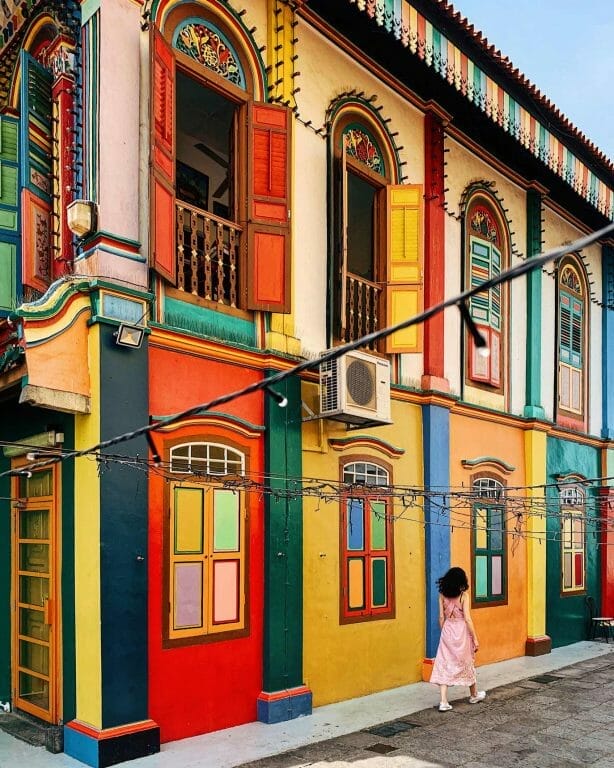
#6 – The Temple Of 1,000 Lights – Sakya Muni Buddha Gaya Temple
Introduction:
Situated in the picturesque Indian quarter, the Sakya Muni Buddha Gaya Temple, which also known as the Temple of a Thousand Lights, is one of the largest and the most visited Buddhist cultural buildings in Singapore. It was founded by a Thai monk in 1927 combining Thai, Chinese and Indian traits in its unusual architecture. Thanks to this eclecticism, the Sakya Muni Buddha Gaya is reckoned to be among the most original of the many temples in the city-state.
The temple became widely famous in Singapore and abroad, mainly because of the 15-meter-high statue of the Buddha that was installed inside. This weighs more than 300 tons and is lined with hundreds colorful icon lamps in a seemingly endless chain. When these are lit during evening hours, the illuminated statue of the legendary founder of Buddhism is a truly remarkable sight. It is this statue, twined with garland of lights and indeed the largest figure of the Buddha in Singapore, which gave the Sakya Muni Buddha Gaya its second name – the Temple of a Thousand Lights (or sometimes the Temple of a Thousand Lamps).
The socle of this imposing statue is adorned with frescos, depicting important events from the great Buddha’s life. There is an entrance to a small room with an altar, under which an image of the reclined Buddha is located, behind the statue. One of the temple’s main relics is kept here: a piece of the Bodhi Tree’s bark. It was while he meditated under that tree that the Prince Gautama reached enlightenment, thus becoming Buddha. Besides the main statue of Buddha, the Temple of a Thousand Lights features many smaller depictions too, as well as paintings that illustrate scenes from his life. A copy of Buddha’s footprint can be seen to the left of the temple’s entrance.
Church members traditionally bring donations to the Singapore Sakya Muni Buddha Gaya Temple during the Vesak holiday, which is devoted to Buddha’s birth and enlightenment. In return, they are allowed to place a leaf of gold on a small statue of the Buddha. As a rule, the figure should be completely covered with a fresh layer of gold leaf by the end of the holiday.
About
Sakya Muni Buddha Gaya Temple is a Buddhist monastery in Singapore. The temple was originally set up by Venerable Vutthisara of Thailand. The present premises are located at Race Course Road in Singapore.
Location: 366 Race Course Rd, Singapore 218638
Opening Hours:
Tuesday : 8am–4:30pm
Wednesday : 8am–4:30pm
Thursday : 8am–4:30pm
Friday : 8am–4:30pm
Saturday : 8am–4:30pm
Sunday : 8am–4:30pm
Monday : 8am–4:30pm
Price of Admission: NIL
Contact: +65 6294 0714
Website: Website Link Here

_
Read Also:
Top 24 Best Indian Restaurants in Singapore
#7 – Tekka Centre
Introduction:
The case of Tekka Centre is often used to illustrate the complexities of Chinese language romanisation in Singapore. The market was originally known as “Kandang Kerbau” (or just “K. K.”), Malay for “buffalo pens”, referring to the slaughterhouses operating in the area until the 1920s, and the name still lives on in the nearby Kandang Kerbau Women’s and Children’s Hospital, Kandang Kerbau Police Station and the Kandang Kerbau Post Office. In Hokkien, the market was known as Tek Kia Kha, literally meaning “foot of the small bamboos”, as bamboo plants once grew on the banks of the Rochor Canal. This was adapted into the popular name Tekka Pasar (笛卡巴刹), where pasar is Malay for “market”.
The original market was built in 1915, and was located across the street between Hastings Road and Sungei Road. site, the new multi-use complex was named Zhujiao Centre (Chinese: 竹脚中心), the pinyin version of Tek Kha. However, to locals, especially non-Chinese, the new word Zhujiao was both hard to read and pronounce and bore no resemblance to Tekka. Eventually, the complex was officially renamed Tekka Centre in 2000 as it better reflected the history of the place. The market was closed for a significant renovation in 2008, reopening in 2009.
About:
Tekka Centre remained a landmark in Little India, where different ethnic communities congregate. There are Chinese stallholders who speak Tamil, and vice versa. Shops sell traditional Indian costumes and inexpensive casual clothes. Some of the more notable shops include those selling Taoist and Buddhist paraphernalia, hardware shops, and tailors who can alter clothes in minutes.
Interior of Tekka Market showing both the ground and second levels, selling food and goods respectively
On the ground floor is a hawker centre with stalls which sell Indian vegetarian meals, served on banana leaves or on stainless steel platters, besides Chinese vegetarian, North Indian and Malay food.
At the wet market which was on the same level, stalls sell fresh seafood, especially crabs from Sri Lanka, and vegetables. There are also many Chinese stalls selling vegetables that are specially flown in from India.
The centre is served by the adjacent Little India MRT station. There are also an underground car park and two taxicab stands. Amenities nearby includes the demolished shopping mall The Verge and Little India Arcade.
Location: 665 Buffalo Road, Singapore 210665
Opening Hours:
Tuesday : 5am–1pm
Wednesday : 5am–1pm
Thursday : 5am–1pm
Friday : 5am–1pm
Saturday : 5am–12pm
Sunday : 5am–12pm
Monday : Closed
Price of Admission: NIL
Contact: +65 8686 6913
Website: Website Link Here

#8 – Abdul Gaffoor Mosque
Introduction:
During Singapore’s period of rapid urbanisation and development in the early 1970s, Muslims were resettled from their villages into Housing and Development Board (HDB) flats at new housing estates. Arising from this was the urgent need to raise funds to build mosques in these new estates.
Whilst the community was willing to contribute, traditional fundraising methods were too slow. An efficient way to raise a community fund from Muslim workers was then devised through the Central Provident Fund Board’s collection system.
Every working Muslim in Singapore, including foreign workers and permanent residents, are to contribute to a community fund – the Mosque Building Fund. The MBF had one key purpose: to build a mosque in every new town.
In 1984, with the establishment of the MENDAKI Foundation, the MBF was then expanded to support Yayasan MENDAKI’s educational and social programmes for the community and was renamed the Mosque Building and Mendaki Fund (MBMF).
About
Originally built in 1859, this masjid with its unique architecture has earned the distinction as one of Singapore’s national monuments. It has an unabashed mélange of styles – a mix of Southern Indian, Moghul and Europeans influences. Located in the Central part of Singapore, it has since been redeveloped (re-opened in 1998) with a capacity of 3000 and offers madrasah classes in Tamil besides its usual religious classes.
Location: 41, Dunlop Street Singapore 209369
Opening Hours:
Monday to Friday: 8:30 am – 5:30 pm
Price of Admission: NIL
Contact: +65 6295 4209
Website: Website Link Here
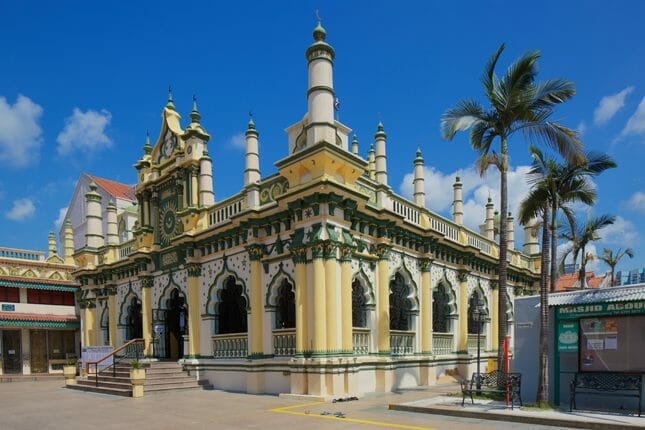
#9 – Mahatma Gandhi Memorial Hall
Introduction:
Proposals on ways to pay tribute to Gandhi emerged soon after his death. At a mass meeting of thousands of mourners at Waterloo Street on 31 January 1948, Indian community leader R. Jumabhoy announced the establishment of a fund to collect $100,000 to erect a statue of Gandhi in Singapore.
About
Singapore’s heritage is rich, diverse, and—most importantly—ongoing. The National Heritage Board strives to preserve and catalogue the elements of that unique inheritance, and to present them to the public in an engaging and accessible format. As the custodians of culture, our goal is to capture the essence of what it means to be Singaporean.
Roots.gov.sg is a major milestone in that effort. Introduced in 2016, it houses our national collection, heritage trails, national monuments, historic sites, Intangible Cultural Heritage, and other multimedia assets under one roof, allowing us to transcend the limits of geography and create a space where Singaporeans can easily sample and share the fruits of our history.
With Roots.gov.sg, we’ve built a bigger doorway to our most cherished stories. We invite you to come inside, discover them, and contribute your own. Help us nurture a heritage for all to own.
Location: 3 Race Course Ln, Singapore 218731
Opening Hours:
Daily
Price of Admission: NIL
Contact: +65 6293 3449
Website: Website Link Here

#10 – Little India Arcade
Introduction:
Little India Arcade consists of a cluster of conserved neoclassical shophouses built in 1913 and is currently owned by the Hindu Endowments Board. An important historical legacy of the arcade is P Govindasamy Pillai’s shop which was formerly situated in the front of the building. He was a prolific philanthropist who gave generously to his community, and was affectionately known as “PGP”. Most of the older Indian temples along Little India are greatly indebted to him for their reconstruction projects, including the Sri Perumal Temple.
It was in the 1910s that PGP found employment as a clerk cum coolie at a provision shop along Serangoon Road. He rose at five in the morning and got to bed only at one in the night. PGP’s big break came in 1929 when he took a loan to buy his employer’s shop upon the man’s death. From selling spices, PGP made his fortune by expanding into the sale of textiles and saris.
Little India Arcade was officially opened in 1995 after having undergone conservation to commemorate the spirit of commerce of the district’s early Indian settlers. This corner building includes the five-foot way (five feet wide covered pedestrian walkway) traditional to Malaya’s colonial-era shophouses. It is now a prominent landmark in the Little India district and houses an array of eateries and boutique shops offering sweets, curios, and other knick-knacks.
About:
Board strives to preserve and catalogue the elements of that unique inheritance, and to present them to the public in an engaging and accessible format. As the custodians of culture, our goal is to capture the essence of what it means to be Singaporean.
Roots.gov.sg is a major milestone in that effort. Introduced in 2016, it houses our national collection, heritage trails, national monuments, historic sites, Intangible Cultural Heritage, and other multimedia assets under one roof, allowing us to transcend the limits of geography and create a space where Singaporeans can easily sample and share the fruits of our history.
With Roots.gov.sg, we’ve built a bigger doorway to our most cherished stories. We invite you to come inside, discover them, and contribute your own. Help us nurture a heritage for all to own.
Location: 48 Serangoon Rd, #02-07, Singapore
Opening Hours:
- Weekdays
- Weekends
- Public Holidays
Price of Admission: NIL
Contact: +65 6295 5998
Website: Website Link Here
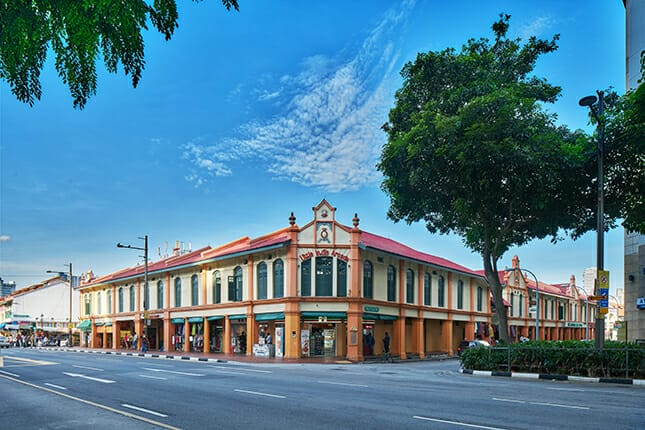

Have a Place to Recommend?
Your contribution is valuable to us! Are there any outstanding businesses that you believe should be added to our list? If so, please send your recommendations to us at [email protected]. Tropika Club will review your suggestions and update the list accordingly. Thank you for your help in making our list of businesses as comprehensive and accurate as possible.
Meanwhile, Check out Tropika Club’s Ecosystem of Websites

Tropika Club Magazine – Tropika Club Magazine is a Singapore-based publication that features articles on a wide range of topics with a focus on local businesses and content for the region. The magazine emphasizes supporting local businesses through its #SupportLocal initiative, which includes coverage of everything from neighborhood hawker stalls to aesthetic clinics in town. In addition to highlighting local businesses, Tropika Club Magazine also covers a variety of local content, including beauty, lifestyle, places, eats, and what’s on in Singapore and the Asia Pacific region.
Tropika Club Deals – Tropika Club Deals is a leading online deals and voucher shopping site in Singapore, offering amazing discounts on beauty, wellness, and fitness products and services. It’s the perfect platform for customers who want to discover the best deals without having to commit to a specific appointment date and time. These deals are available at major beauty stores, facial salons, hair salons, and other brands in Singapore, with no minimum spend required. Choose from guaranteed discounted deals in the categories of hairstyling, hair removal, facial & aesthetics, body slimming, brows & lashes, nails & makeup, massage & spa or fitness & wellness. Tropika Club Deals is also ideal for customers who want to buy vouchers as gifts or to use for the future. So whether you’re looking to save money on your next haircut or want to treat yourself to a relaxing massage, Tropika Club Deals has got you covered with the best voucher and coupon deals in Singapore!



